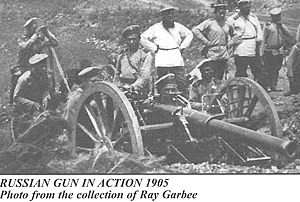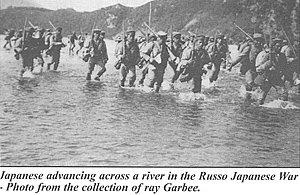 This Russo-Japanese War battle was fought by a small group of Williamsburg, Virginia gamers (Toby Barrett, Elliott Haller, Rich Villella, Carl West and the author) on a 6’ by 8’tabeltop using modified Sword and the Flame rules (Revision 1+). The author’s collection of 25mm Falcon and Frontier figures are organized to fight regimental or brigade level battles of less than 200 miniatures per side on 1:25 ratio. All infantry figures are mounted on 2-man stands, while all others are individually mounted.
This Russo-Japanese War battle was fought by a small group of Williamsburg, Virginia gamers (Toby Barrett, Elliott Haller, Rich Villella, Carl West and the author) on a 6’ by 8’tabeltop using modified Sword and the Flame rules (Revision 1+). The author’s collection of 25mm Falcon and Frontier figures are organized to fight regimental or brigade level battles of less than 200 miniatures per side on 1:25 ratio. All infantry figures are mounted on 2-man stands, while all others are individually mounted.
The rules modifications allow the Japanese to fight as “British” and the Russians as “Egyptians.” All hearts cards drawn are casualties to be removed (so as to represent the high casualties of this war), and critical morale is checked at the battalion or detached company level if their commanders are casualties. Thus, an almost neo-Wellsian tabletop battle usually results.
The HO-scale railroad running east and west bisected the length of the table, and the track bed was considered Class III cover. The River was passable only at the bridges or by small boat. A cluster of log buildings, tents and a watchtower comprised the station. The woods to the southwest and northwest provided a small degree of hidden movement and was Class III cover.
BATTLE SCENARIO AND SETUP
Late in the war, the Japanese launched a raid into Russian territory in an effort to disrupt the now steady flow of European Russian reinforcements entering the war. A weakly guarded station near a vulnerable Trestle was their target, and they would have a limited time to achieve the objective (two “days” of about 10 turns each). Rules for tearing up or repairing track or destroying the Trestle were agreed to before the game started (i.e., die rolls and time needed).
RUSSIAN FORCES
The 1st Siberian Rifle Regiment of 3 battalions (each of 4 x 6-man companies), a Maxim gun and an engineer company were deployed at the station (90 men total). One battalion was “patrolling” on the Main Road “off the table” to the north, but it could return on turn 1, 2 or 3 decided by a die roll after firing commenced.
An Amur Cossack Sotnia (12 troopers) and a 1-gun horse battery was “patrolling” on the Secondary Road “off the table” to the northwest, but it too could arrive on turn 1, 2 or 3 decided by a die roll after firing commenced.
The 2nd Siberian Rifle Regiment of 2 battalions (each of 4 x 6-man companies) and a 2-gun artillery battery were a day’s march away on the Secondary Road “off the table” to the northwest, but it could not arrive until the second day (turn 1, 2 or 3 per a die roll).
 JAPANESE FORCES
JAPANESE FORCES
The 1st Infantry Battalion (4 x 10-man companies) and sapper engineers were deployed at the table’s edge between the Main Road and the edge of the woods, supported by a party of sailors in a small boat coming upriver (55 men total).
The 2nd Infantry Battalion (4 x 10-man companies) and a 2-gun artillery battery were deployed at the table’s edge between the Main Road and the southeast hill, supported by a squadron of Dragoons and a party of mounted Chinese mercenaries (65 men total).
The 3rd Infantry Battalion (4 x 10-man companies) was in reserve to the south on the Main Road (45 men total) but could not arrive until turn 1 on the second day.
Back to Table of Contents -- Courier # 83
To Courier List of Issues
To MagWeb Master Magazine List
© Copyright 2002 by The Courier Publishing Company.
This article appears in MagWeb (Magazine Web) on the Internet World Wide Web.
Other military history articles and gaming articles are available at http://www.magweb.com